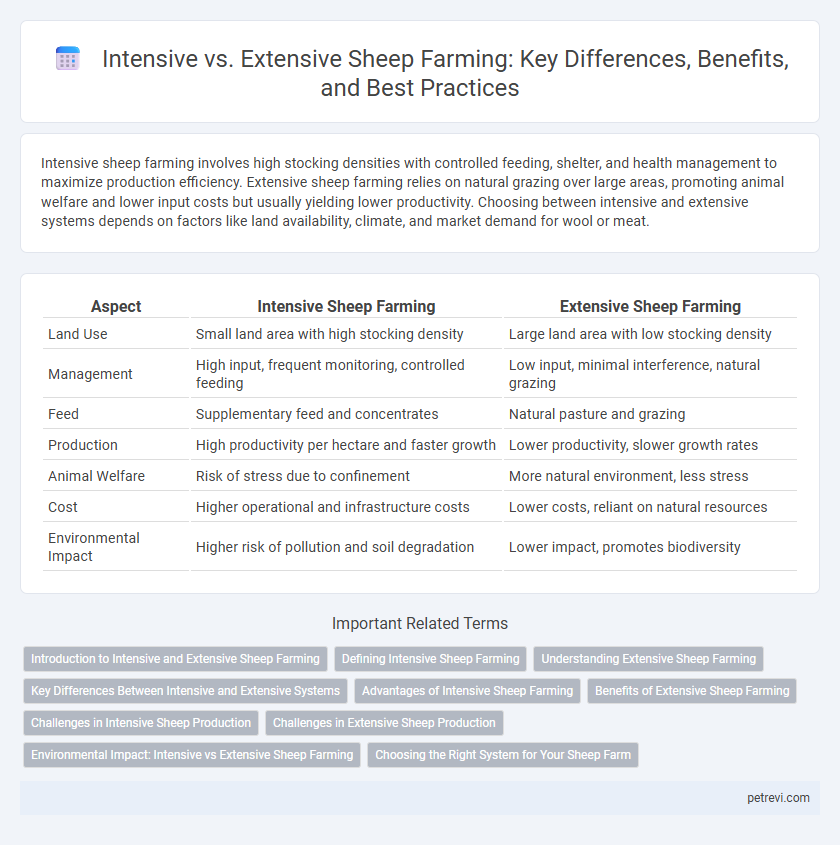Intensive sheep farming involves high stocking densities with controlled feeding, shelter, and health management to maximize production efficiency. Extensive sheep farming relies on natural grazing over large areas, promoting animal welfare and lower input costs but usually yielding lower productivity. Choosing between intensive and extensive systems depends on factors like land availability, climate, and market demand for wool or meat.
Table of Comparison
| Aspect | Intensive Sheep Farming | Extensive Sheep Farming |
|---|---|---|
| Land Use | Small land area with high stocking density | Large land area with low stocking density |
| Management | High input, frequent monitoring, controlled feeding | Low input, minimal interference, natural grazing |
| Feed | Supplementary feed and concentrates | Natural pasture and grazing |
| Production | High productivity per hectare and faster growth | Lower productivity, slower growth rates |
| Animal Welfare | Risk of stress due to confinement | More natural environment, less stress |
| Cost | Higher operational and infrastructure costs | Lower costs, reliant on natural resources |
| Environmental Impact | Higher risk of pollution and soil degradation | Lower impact, promotes biodiversity |
Introduction to Intensive and Extensive Sheep Farming
Intensive sheep farming involves raising a high number of sheep per unit area, utilizing controlled feeding, housing, and veterinary care to maximize production efficiency and wool or meat output. Extensive sheep farming relies on large grazing areas with minimal human intervention, allowing sheep to roam freely and feed on natural pastures, which is more sustainable and suited for regions with vast open land. Both methods are adapted to different environmental conditions and economic goals, impacting animal welfare, productivity, and resource use.
Defining Intensive Sheep Farming
Intensive sheep farming involves high-density stocking with controlled feeding, housing, and health management to maximize productivity per unit area. This method emphasizes rapid growth rates, selective breeding, and mechanized processes to increase wool or meat yield efficiently. It contrasts with extensive systems by prioritizing resource input and animal supervision over natural grazing and lower stock densities.
Understanding Extensive Sheep Farming
Extensive sheep farming involves raising sheep on large open pastures with minimal human intervention, relying on natural grazing resources and adapting to the environment's carrying capacity. This method promotes sustainable land use, reduces feed costs, and supports animal welfare by allowing sheep to exhibit natural behaviors. Extensive systems are commonly practiced in regions with abundant grazing land, such as Australia and New Zealand, offering benefits for wool and meat production under low-input management.
Key Differences Between Intensive and Extensive Systems
Intensive sheep farming involves high stocking densities, controlled feeding regimes, and increased veterinary care to maximize production on limited land, resulting in higher outputs per hectare but greater input costs. Extensive sheep farming relies on natural grazing over large areas with minimal interventions, lowering operational costs and environmental impact but typically yielding lower production efficiency. Key differences include land use intensity, resource input levels, and management practices that influence productivity and sustainability outcomes.
Advantages of Intensive Sheep Farming
Intensive sheep farming maximizes productivity by utilizing controlled environments, advanced feeding strategies, and selective breeding to achieve higher wool and meat yields per acre. This method enhances disease management and reduces predation risks, ensuring consistent animal health and improved product quality. Efficient land use in intensive systems supports higher stocking densities, optimizing economic returns for farmers.
Benefits of Extensive Sheep Farming
Extensive sheep farming benefits include lower feed and labor costs due to natural grazing on large pasture areas, which promotes animal welfare and reduces environmental impact. This method enhances genetic diversity and resilience by allowing sheep to adapt to varied terrains and climates. Extensive systems also contribute to sustainable land management by improving soil health and preventing overgrazing.
Challenges in Intensive Sheep Production
Intensive sheep production faces challenges such as high feed costs, increased disease risks, and environmental management issues including waste disposal and land degradation. Maintaining animal welfare in confined spaces requires rigorous health monitoring and biosecurity measures. These factors contribute to higher operational complexity compared to extensive sheep farming systems.
Challenges in Extensive Sheep Production
Extensive sheep production faces challenges such as variable pasture quality, susceptibility to harsh weather conditions, and increased risk of predation, all of which impact flock health and productivity. Limited access to veterinary care and high labor demands for monitoring widespread flocks further complicate management. These factors often lead to lower growth rates and reproductive performance compared to intensive systems.
Environmental Impact: Intensive vs Extensive Sheep Farming
Intensive sheep farming often leads to higher greenhouse gas emissions per area due to concentrated waste and increased feed requirements, contributing to soil degradation and water pollution. Extensive sheep farming typically results in lower environmental impact by promoting natural grazing patterns, enhancing biodiversity, and maintaining soil health. However, extensive systems may require more land, potentially leading to habitat fragmentation if not managed sustainably.
Choosing the Right System for Your Sheep Farm
Intensive sheep farming maximizes production through controlled feeding, shelter, and close monitoring, resulting in higher yields per acre but increased costs and labor. Extensive sheep farming relies on natural grazing over larger pastures, promoting sustainable land use and lower input expenses while potentially limiting productivity. Selecting the right system depends on factors such as farm size, available resources, climate conditions, and market demands to balance profitability and animal welfare effectively.
Intensive vs Extensive for Sheep Farming Infographic

 petrevi.com
petrevi.com